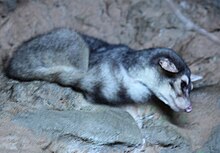

| Cacomistle | |
|---|---|

| |
| Scientific classification | |
| Domain: | Eukaryota |
| Kingdom: | Animalia |
| Phylum: | Chordata |
| Class: | Mammalia |
| Order: | Carnivora |
| Family: | Procyonidae |
| Genus: | Bassariscus |
| Species: |
B. sumichrasti
|
| Binomial name | |
| Bassariscus sumichrasti (Saussure, 1860) | |

| |
| Cacomistle range | |
The cacomistle (/ˈkækəˌmɪsəl/;[2][3] Bassariscus sumichrasti), also spelled cacomixtle,[4][5] is a primarily nocturnal, arboreal, omnivorous member of the carnivoran family Procyonidae (coatis, kinkajous and raccoons). Depending on the location, its preferred habitats are humid and tropical evergreen jungle and montane cloud forests; seasonally, it may venture into drier, deciduous forests.
Although its total population is listed as being of "least concern" (i.e., stable), the cacomistle is still a highly cryptic, secretive animal, and generally an uncommon sight throughout much of its range (from southern México to western Panamá); this fact is especially true in Costa Rica, where it inhabits only a very small area. Additionally, the species is completely dependent on trees and dense vegetation for habitat, making it particularly susceptible to deforestation.
The name cacomistle comes from the Nahuatl language (tlahcomiztli) and means "half-cat" or "half-puma";[6] the same name is also given, by some, to the North American Bassariscus astutus, more commonly known as the ringtail (or, semi-inaccurately, ringtail 'cat'). This "sister species" of the cacomistle inhabits a much more northerly and less tropical range, from arid Northern Mexico into the Southwestern United States.
The cacomistle is one of two extant species in the genus Bassariscus, along with its close relative, the North American ringtail (Bassariscus astutus). Together, they form the Procyoninae, a subfamily of the greater Procyonidae of the Carnivora order, thus placing them with raccoons, coatis, olingos and kinkajous.
Currently, six regional subspeciesofBassariscus sumichrasti are recognized:

This species of cacomistle's body is 38–47 cm in length, which is attached to a tail of approximately the same length, if not longer (typically 39–53 cm long). The male cacomistle is often slightly longer than its female counterpart, however both male and female have approximately the same weight, usually between 1 and 1.5 kg.[8] Their body consists of dark brown and grey fur, which stands as a stark contrast to the black and white striped tail. The tail stripes are the most defined near the animal's posterior end and gradually fade to a solid black at the end of the tail. The cacomistle is often confused with its close relative the Ring-tailed cat (Scientific name: Bassariscus astutus) because of the similarity of their appearance, but unlike the ring-tail cat the cacomistle does not have retractable claws. The cacomistle can also be identified by its faded tail and the observation of ears that come to a point.[7]
The cacomistle inhabits the tropical forests of North America and Central America, from south-central MexicotoPanama. These animals are quite solitary and thus spread themselves out, with each cacomistle having a home range of at least 20 hectares (an area equivalent to 20 sports fields)[9] and are typically seen in the middle and upper levels of the canopy.[7] Throughout their broad range this species is found to inhabit a wide variety of different forest ecosystems. In Mexico, the cacomistle tends to avoid oak forests, secondary forest, and overgrown pastures, but in Costa Rica, the cacomistle has been shown to favor those exact habitats.[8]
Cacomistles are considered generalist feeders, because they can survive on a wide variety of different foods.[8] The diet of this species consists primarily of fruits, insects, small vertebrates such as reptiles, amphibians, and rodents, the specificity of these food options depends on what is available in the particular habitat in which an individual dwells.[7] The bromeliad is an excellent reservoir for food in the southern edge of the cacomistle's range, as these plants naturally collect water, insects and small animals found high in the canopy.[8]
Mating season is the only time cacomistles interact with each other, and it is only briefly as the female is only receptive to male approaches for one day. After mating, the female cacomistle undergoes a gestation period of approximately two months before giving birth to a single offspring. When the cub is three months old it is weaned, and then taught hunting and survival skills by its mother before going off to develop its own territory.[10]
{{cite journal}}: CS1 maint: multiple names: authors list (link)
| Bassariscus sumichrasti |
|
|---|---|
| Bassaris sumichrasti |
|